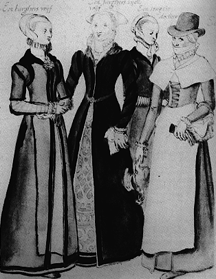
A group of English London Ladies
by Lucas de Heere
circa 1570
Add. Ms. 28330, British Museum
The 1570s and 1580s were the age of the "typical" elizabethan dress, or what the average person thinks of when they envision Queen Elizabeth's court. (That is, if the average person actually envisions such things...) but regardless, this tour will contain a number of gowns from the 1570s and 1580s, from a number of countries, to provide you with as broad a spectrum of fashion as possible--and make no mistake, it was quite broad.
First, let's look at street scene by a flemish visitor to England. This drawing of Heere's gives us a valuable look at lower and middle class English fashion--the clothing worn by those who could not afford portraits painted of themselves, and who in any case wouldn't have worn their street clothes for such a painting.
If you contrast the dress of these women with, say, the clothing worn by An Unknown Girl painted the year before, the most obvious difference between them is its simplicity of the London womens' outfits. There is no lavish use of brocade, pearls, precious metals, velvet or other silk fabrics, nor is there any of the elaborate embroidery so often seen in portraits of the time. The ladies' gowns don't have the typically "busy" look of upper-class Elizabethan garments, but retain some of the Tudor simplicity of line and form.
The middle woman's underskirt is made of brocade, but the skirt and the cut of the gown is much narrower and more economical than that of the pleated overskirts and voluminous puffed sleeves often worn by Elizabeth's courtiers and ladies in waiting. In general, the richer a lady was, the more fabric she could afford to use in her gown. (see Fabric Use in 16th C. England for a comparison of yardages used for middle class and noble costume).
The skirts do suggest the use of a modest farthingale, stiffened with wood or perhaps channels tightly stuffed with rope or rags. The sleeves are narrow, and the only form of decoration--aside from the color of the fabric itself--is the use of piping or trim, in this case of velvet, to accent seams and skirt hems.
The sillouhette of the women also differ from those of other portraits of this time. The women here are wearing gowns over their skirts and bodices; They lack the stiffened, v-shaped stomacher, the tabs at the waist, and the shoulder picadils and puffs. The bosom is more rounded, and the two gowns to the left seem to lack even a distinct waistline. They do include high ruffs about the neck, however, and a fall-back collar as well. The ruffs are much smaller than those common amongst the nobility.
A less obvious difference is that all of the dresses lace up the front--much easier to put on by yourself. The headdress, aside from the one fishwife wearing a hat, consists of simple coifs--the most common headwear of the middle-class woman. The coif of the woman to the left is wired for stiffness. All women are wearing or carrying gloves, an important fashion accessory of the day.
The fishwife is of a lower class than the rest of the women portrayed; her bodice laces up the front over a stomacher, a style seen in other pictures of lower-class market women. She wears an apron, and wrapped around her shoulders is a sort of short cape reminiscent of an early 19th century pelisse. A chin-clout covers her mouth and lower face.